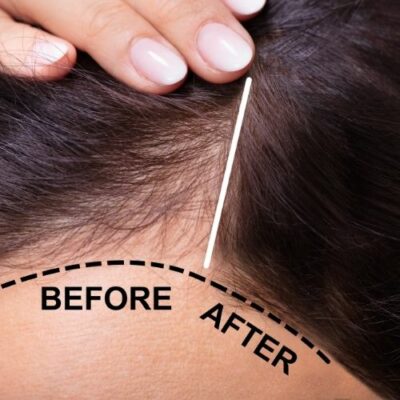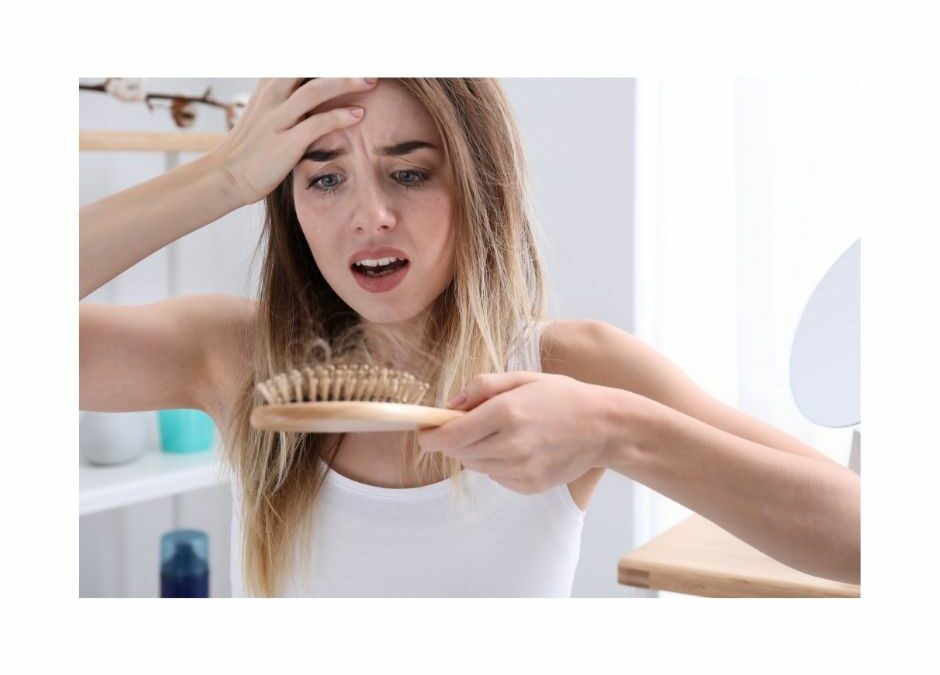Women with thinning hair often feel vulnerable and appear less confident. Women with beautiful thick hair often exude self confidence and radiate beauty. Did you know that in America 30 million women suffer with hair loss? That is a statistic of 1 in 11 women who are struggling with thinning hair. People always notice your hair. In fact many people will stare at your hair before they look at your face. If your hair is having a ‘bad hair day’ – so are you. You may have been at the receiving end of someone you meet raising the level of their eyes and staring at your hair. There is just no way to escape the sick feeling in the pit of your solar plexus. Let’s talk about women with thinning hair and explore reasons and options for treatment.
Women With Thinning Hair. What is the cause?
There are many reasons for thinning hair in females. The most common one tends to be hereditary.
- Female Pattern Balding also known as Androgenetic Alopecia is hereditary
- Post natal and beyond hair loss
- Improper hair care treatment and overuse of hair styling products eg dyes, perms, sprays,
- Hair styles that pull the hair tight like ponytails and tight braiding – traction alopecia
- Various diseases like thyroid diseases / cancers and the treatment thereof
- Lack of protein / iron / ferritin can cause hair loss
- Prescription drugs can cause hair loss
- Birth control tablets
- Hormonal imbalances
- Menopause and Perimenopause
- Excessive androgens
- Polycystic Ovarian Syndrome (PCOS)
- Fungal infections
- Stress
- Psychological imbalances like hair pulling
- Alopecia Areata which is hair falling out in patches leaving areas totally bald. This is temporary.
- COVID-19
and others.
Many of these hair loss causes can be reversed although it is not an instant gratification. Hair regrowth requires patience and tenacity while you keep working to get your crowning glory back.
The 4 Stages of the Hair Growth Cycle
Hair goes through 4 stages of hair growth in a cycle.
- Anagen (Growth Stage)
- Catagen (Transition Stage)
- Telogen (Resting Stage)
- Exogen (Shedding)
Anagen Phase
The hair is formed in the hair bulb and dermal papilla (root and the shaft) and then grows for up to 10 years. The majority of hair follicles are in the this phase at any given time. This phase is the reason we need to go for a hair cut.
 Catagen Phase
Catagen Phase
After the anagen phase your hair moves in the short term phase known as the catagen phase. Catagen phase only last a couple of weeks. At this point the hair disconnects from the blood supply and the hair goes into a transitional stage known as the club hair stage.
Telogen Phase
In normal hair growth, the club hair has a new hair beginning to grow in the bulb below. The new hair will ultimately replace the club hair, starting in the anagen phase again. 10-15% of all hairs on the head are in this phase at any one time. This phase takes about 3 months.
Exogen PhaseThe exogen phase is the shedding phase and is the final part of the hair cycle. The resting hair releases and falls out of your head while the new hair begins to grow through returning to the anagen phase. Shedding is a normal part of hair loss and it is documented that 50 to 100 hairs shed a day.
What Can You Do About Women’s Thinning Hair
Many women think there is nothing they can do about thinning hair. That is not true.
Bloodwork
The primary importance is to get an appointment with a dermatologist who specializes in hair care and not one who specializes cosmetic surgery. A dermatologist who specializes in hair loss will need to cover many aspects of bloodwork. Your body has to function well in order to grow your hair back or to improve the condition of your hair. Thyroid tests including Free T3 and Free T4, white and red blood cell counts, hormone levels and vitamin levels. Vitamin D and Vitamin B levels are really important to balance in order to support healthy hair and vitamin C is needed to absorb iron. Kidney and Liver functions, protein levels, trace elements which include iron and ferritin are just as prevalent in female hair loss.
If you have stomach issues like bloating, constipation, diarrhea, etc, get tested for Sibo (small intestine bacterial overgrowth). Many doctors are quick to brush off stomach issues. They give it a label of IBS. There are treatment protocols for Sibo. A naturopath or nurse practitioner can test for Sibo. Not many doctors are familiar with the condition and therefore they can misdiagnose it.
Diagnosis
AGA – androgenic alopecia is the same as FPHL which is female pattern hair loss.
FPHL – female pattern hair loss – see AGA above
AA – Alopecia areata is an autoimmune condition where the body’s immune system attacks healthy tissues. This causes the hair to fall out in circular patches and stops new hair from growing. This condition can affect all / any area of the body, however the hair and eyebrows being the most disconcerting and noticeable.
AT – Alopecia totalis is the total loss of hair on the scalp leaving the scalp totally bald.
AU – Alopecia universalis is the total loss of hair on the body and the scalp and is an advanced form of Alopecia areata
TE – telogen effluvium – this condition is when large numbers of follicles go into resting phase of the hair cycle and the next growing phase fails to start up.
Treatments for Women With Thinning Hair
Once you have the bloodwork done your dermatologist can consider the next options. Sometimes you may be referred to an endocrinologist for further investigation and treatment. Many times the dermatologist will do a biopsy on your head and based on those results come up with a treatment plan.
The treatment plan can cover a combination of treatments or just one.
Here are some of the most popular
 Minoxidil Topical – 3% and 5% strength. Start with 3% and if you have no bad reactions try the 5% once a day or as directed. This comes in a liquid or foam product. The liquid goes straight onto the scalp with a dropper and possibly sinks in more easily and offers lest wastage. The foam is harder to reach the skin and by adding the minoxidil mousse to ones hands, it could possibly lesson the strength. There is no science either – it is just according to personal preference and use.
Minoxidil Topical – 3% and 5% strength. Start with 3% and if you have no bad reactions try the 5% once a day or as directed. This comes in a liquid or foam product. The liquid goes straight onto the scalp with a dropper and possibly sinks in more easily and offers lest wastage. The foam is harder to reach the skin and by adding the minoxidil mousse to ones hands, it could possibly lesson the strength. There is no science either – it is just according to personal preference and use.- Minoxidil Oral Tablets – These tablets proport to relax the blood vessels increasing the blood and oxygen to your heart and is a vasodilator. They are supposed to be an effective treatment for androgenic alopecia in women.
- Ketoconazole – is an antifungal shampoo with anti androgenic properties for use in female pattern hair loss (FPHL).
- Scalp Dermarolling – use a dermaroller (similar to the skin dermaroller) lightly on your head using 0.25mm needles to start. By rolling the dermaroller lightly across your scalp, it causes increased blood to flow to to the area and the subsequent release of growth factors which means your stimulate hair growth. This has proven to help hair growth and thickness using your hair care products to support this.
- Microneedling – is the process of electronically charged sharp needles, which make tiny punctures in the skin. This causes the skin to produce collagen to repair the area. The process increases oxygen supply to the skin and encourages new hair growth
- Spironolactone – decreases the testosterone levels in the bloodstream by slowing down the testosterone production in your adrenal gland. This medication together with minoxidil 5% topical treatment has been known to improve hair growth in women with thinning hair.
- Finasteride – Although finasteride is being used mostly for men – women are being prescribed this product at a higher dosage. It is a DHT (dihydrotestosterone) blocker. DHT is the link to hair loss in both men and women. Finasteride, like many other drugs do have side affects and it’s best to work with a dermatologist to get the best plan to treat your hair.
- PRP Therapy – Platelet Rich Plasma therapy is a process in which your own blood is drawn, processed and injected into your scalp. A minimum of 3 sessions are required and it is costly, with some fair results.
- Birth control pills also play a huge part in hair loss and hair growth. Be sure to check with your dermatologist which pill you should be taking to keep your hair growing and healthy, while protecting you from any unwanted pregnancies.
- Rosemary Oil – mix a little rosemary oil in with your shampoo as it stimulates and improves circulation to the scalp. Rosemary oil can also minimize the conversion of testosterone, so blocking the hormone receptors in the shaft. Always dilute rosemary with a carrier oil (like coconut) if you do not use it in your shampoo as you run the risk of burning your scalp over a longer period.
- Biotin / Collagen – supports hair, skin and nails – win win right?
- Saw Palmetto – is also a natural DHT blocker.
- Pumpkin seed oil – is also a natural DHT blocker
- Aloe Vera – Aloe vera is high in proteolytic enzymes which are enzymes that break down protein – which ultimately stimulates hair follicles. Mix 1 cup of Aloe Vera and 2 Tablespoons of castor oil to make a a natural boost for hair growth.
- Lazer Cap or Lazer Band – various brands and seems consistency is best. Read the reviews!
- Hair Transplant Surgery – This process includes surgically removing thin bands of hair from other parts of your head and transplanting them into the thinning / balding areas.
Diet and Exercise
There would be no point in doing any hair treatments without taking a look first at the state of ones health, diet and exercise programs. It’s important to eat responsibly and walk a every day, which will increase your oxygen flow in your blood. Small changes in your health and lifestyle can improve your hair quality and quantity. Don’t you deserve to show the best version of yourself?
 Wigs and Toppers
Wigs and Toppers
Today there is no shame in wearing a wig or a hair topper. Many synthetic wigs look so natural and are more cost effective than their real hair counterparts. Toppers can be weaved into the hair or clipped in. With a little styling by a hair dresser who specializes in wigs, you can live confidently knowing you look gorgeous. Wear your wig or topper in a new situation first. People that don’t know you won’t judge you. Choose your family and friends carefully when showing them the new you. People familiar to you are insensitive and say things they shouldn’t – so know that ahead of time and be prepared.
Summary
There are so many options available today to help women with thinning hair. Research products, join groups and find your tribe, but whatever you do – do not suffer in silence. There is help available to you with many options covered by your insurance. There is so much advice available at the tip of your fingers to help you restore your hair or rock your options. Just know that there are lots of women with thinning hair just like you and we are in this together.

This is a very important post. Because thinning hair is a problem that everyone has today. But I just saw an elaborate post like this today. Stess also causes thinning hair. That’s really surprising. And you have even shown the solution to that problem in this. I will definitely be sharing this. Thanks so much for posting like this. Keep posting like this.
Fascinating topic. With boldness running in my family, I am terrified of becoming bold. Well, there is no shame in being afraid. Nowadays, the world is more concerned about how people look, and first impressions are a must.
Thank you for the informative article, and I must say I am lesser concerned because since I have been looking after my hair, like massaging my sculp, and using the correct shampoo, I have not yet seen any signs of boldness and that is a good thing.
Keep up the good work!
Thank you Enrico – have a wonderful day!
Thinning hair, hair fallout, and baldness can be very traumatic for women. I´m glad you listed a long list of causes, and I think stress can be a big factor because most people are under a lot of stress, and sometimes they don´t even know it.
Thank you for going into detail about the phases of hair growth. I think after reading this, many people may not look at their hair the same way again.
Thank you Dana, yes I agree – Stress is a major factor for hair loss!